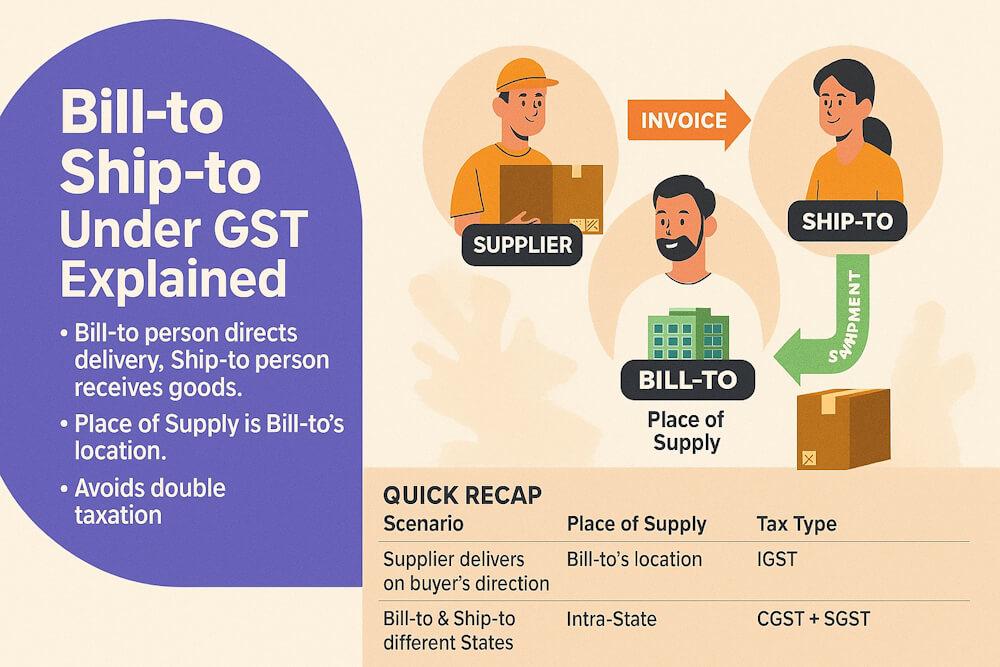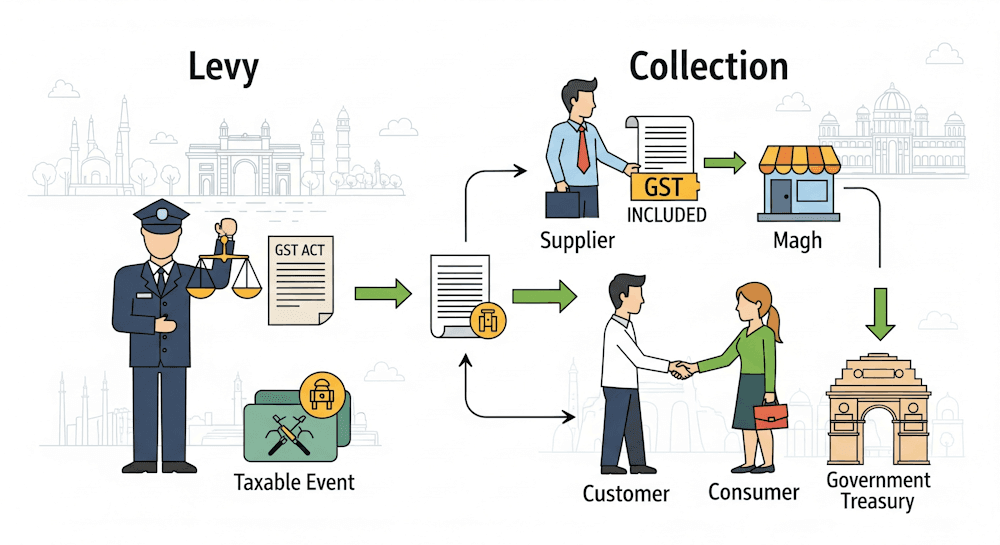1. Introduction
One of the most common supply arrangements in business today is the Bill-to Ship-to model — where the person who pays for the goods isn’t the one who actually receives them.
This model exists everywhere — distributors shipping directly to customers, e-commerce sellers fulfilling third-party orders, or corporate buyers redirecting deliveries.
Under GST, determining the Place of Supply (PoS) for such transactions is crucial, because it decides whether you should charge IGST or CGST + SGST, and also which State receives the tax revenue.
Section 10(1)(b) of the Integrated Goods and Services Tax (IGST) Act, 2017 specifically deals with such transactions.
2. Understanding the Concept
In a Bill-to Ship-to situation:
- “Bill-to” = the person who places the order and gets billed (the buyer).
- “Ship-to” = the person to whom the goods are delivered (the consignee).
Although the goods physically move to the “Ship-to” party, for GST purposes, the supply is deemed to be made to the “Bill-to” person — the one who directs the delivery.
So, even though two invoices or movements may happen, the law treats it as two distinct supplies:
- First supply – between the original supplier and the person who orders the goods (the Bill-to).
- Second supply – between the Bill-to person and the ultimate recipient (the Ship-to).
3. Legal Provision – Section 10(1)(b)
The IGST Act says:
“Where the goods are delivered by the supplier to a recipient or any other person on the direction of a third person, whether acting as an agent or otherwise, it shall be deemed that the said third person has received the goods and the place of supply shall be the principal place of business of such person.”
Let’s simplify that:
1. There are three parties:
- The supplier, who sends goods.
- The third person (Bill-to), who gives direction for delivery.
- The recipient (Ship-to), who receives goods physically.
2. The law deems that the goods have been delivered to the “third person” (the Bill-to).
3. Therefore, the Place of Supply = the principal place of business of the Bill-to person, not the place where goods are delivered.
This ensures that tax flows correctly to the State where the “Bill-to” buyer is registered.
4. Why This Rule Exists
Before GST, dealers often faced double taxation when one invoice and delivery covered two States. Under VAT/CST, the State of movement and the State of billing both wanted tax.
Section 10(1)(b) removes this confusion by deeming the Bill-to person as the recipient, ensuring only one tax transaction per supply chain step.
5. Example 1 – Three Different States
Scenario:
- Y & Co., registered in Ahmedabad (Gujarat), sells goods to X & Co., registered in Noida (U.P.), on X’s instructions.
- X tells Y to deliver goods directly to Z & Co., located in Jaipur (Rajasthan).
Transaction flow:
- Y → X = First Supply (deemed delivery)
- X → Z = Second Supply (actual delivery)
| Supply | Supplier | Recipient | Delivery To | Place of Supply | Type |
| 1 | Y (Gujarat) | X (U.P.) | Z (Rajasthan) | U.P. | Inter-State |
| 2 | X (U.P.) | Z (Rajasthan) | Z (Rajasthan) | Rajasthan | Inter-State |
Explanation:
- For the first supply (Y→X), PoS = U.P. (principal place of X).
- For the second (X→Z), PoS = Rajasthan (where delivery ends).
Thus, two separate IGST transactions occur, even though goods move directly from Gujarat → Rajasthan.
6. Example 2 – Bill-to and Ship-to in Same State
Scenario:
A trader in Pune (Maharashtra) buys goods from a supplier in Nagpur (Maharashtra) and instructs him to deliver directly to the buyer’s customer in Mumbai (Maharashtra).
Here:
- Supplier (Nagpur) → Trader (Pune) – deemed delivery to Pune.
- Trader (Pune) → Customer (Mumbai) – actual delivery.
👉 For both transactions, the supplier and recipient are within the same State (Maharashtra).
Result: Both are intra-State supplies → CGST + SGST applicable on each.
7. Example 3 – Two Supplies, One Movement
Let’s take a real-world industrial example.
Scenario:
Steel Makers Ltd. (Chhattisgarh) supplies machinery to Auto Build Ltd. (Maharashtra), who instructs them to deliver it directly to Speed Motors Ltd. in Tamil Nadu.
1. First supply: Steel Makers → Auto Build
- PoS = Maharashtra (Auto Build’s registered place)
- Tax = IGST
2. Second supply: Auto Build → Speed Motors
- PoS = Tamil Nadu (where delivery ends)
- Tax = IGST
One physical movement (Chhattisgarh → Tamil Nadu) covers two taxable supplies under GST.
8. Conditions for Applying Section 10(1)(b)
For this rule to apply, certain conditions must be met:
- Delivery on direction of a third person: - The supplier must deliver goods to someone else as instructed.
- Instruction before or during movement: - The direction to deliver must exist at or before dispatch.
- Bill-to person is registered: - The rule primarily covers registered Bill-to entities (for unregistered, clause ( ca ) applies).
- Proper documentation: - Tax invoices, e-way bills, and delivery challans must clearly mention both “Bill-to” and “Ship-to” details.
If these are met, the transaction qualifies as “Bill-to Ship-to”.
9. Two-Leg Documentation Example
Continuing Example 1:
| Document | Issued by | To | Shows Delivery at | Notes |
| Invoice 1 | Y & Co. | X & Co. (U.P.) | Z & Co., Jaipur | First supply under Sec 10(1)(b) |
| E-way bill 1 | Y & Co. | X & Co. | “Ship-to” – Z & Co. | Movement proof |
| Invoice 2 | X & Co. | Z & Co. | Jaipur | Second supply |
| E-way bill 2 | X & Co. | Z & Co. | Jaipur | Second leg movement |
Even though goods physically travel once, both invoices must exist for GST compliance.
10. Multiple Bill-to–Ship-to Chains
Sometimes, more than three parties are involved. Example — A instructs B to deliver goods to C, and C further asks for delivery to D.
In such cases:
- A separate “deemed” supply occurs at each chain level.
- GSTN has clarified (Circular No. 37/11/2018-GST) that only the first instruction (A → B → C) can apply Sec 10(1)(b); subsequent legs are taxed based on movement and ownership.
So, the chain cannot extend indefinitely under a single 10(1)(b) cover.
11. Special Situations
(a) When Goods Move via Transporter’s Godown
If the transporter temporarily stores goods, it doesn’t change the place of supply. The final delivery point still decides the PoS.
(b) E-Commerce “Drop-Shipment”
When an e-commerce seller directs the supplier to deliver directly to the customer, this is a Bill-to Ship-to case. Platform invoices must mention both buyer’s and customer’s GSTIN or State name.
(c) Imports / Exports
When one leg is outside India, Section 10(1)(b) read with Section 11 applies. If the final destination is outside India, it becomes an export (zero-rated).
12. Clarifications by CBIC (Latest Updates)
| Date / Circular | Update | Key Impact |
| Circular No. 209/3/2024-GST (13 July 2024) | Clarified that “Bill-to–Ship-to” applies even if Bill-to person is unregistered, but then clause ( ca ) governs place of supply. | Simplifies B2C drop-ship cases. |
| Notification No. 09/2024-IGST (8 Oct 2024) | Introduced clause ( ca ) – supplies to unregistered persons. Delivery address decides PoS when invoice shows both Bill-to and Ship-to. | Retail & e-commerce transactions affected. |
| E-invoicing rules update (Aug 2024) | “Bill-to” and “Ship-to” fields mandatory for invoices under Section 10(1)(b). | ERP & accounting software must map correctly. |
13. Practical Compliance Checklist
- Ensure invoice mentions both “Bill-to” and “Ship-to” details.
- Include GSTIN and State code of both parties.
- Generate e-way bills using the correct combination (Bill-to + Ship-to).
- Maintain instruction proofs (email / PO / agreement) showing Bill-to person directed delivery.
- In returns, report supplies with accurate PoS so that GSTR-1 auto-validates correctly.
14. Common Mistakes to Avoid
- Treating Bill-to Ship-to as a single supply.
- Charging CGST + SGST instead of IGST when States differ.
- Missing address for unregistered recipient → defaults to supplier’s State.
- Wrong e-way bill entry (only “Ship-to” shown).
- Failing to raise a second invoice in chain supplies.
All these lead to mismatch and penalties during departmental audits.
15. Why This Rule Is Business-Friendly
Section 10(1)(b) helps avoid tax duplication and keeps logistics flexible. Distributors, stockists, and e-commerce operators benefit because goods can move directly to customers without routing through the buyer’s warehouse — saving time and cost.
It also keeps revenue allocation fair between States, aligning GST with its destination-based principle.
16. Quick Recap Table
| Scenario | Section | Place of Supply | Tax Type |
| Supplier delivers on buyer’s direction | 10(1)(b) | Bill-to’s principal place of business | IGST / CGST + SGST |
| Bill-to & Ship-to same State | 10(1)(b) | Same State → Intra-State | CGST + SGST |
| Bill-to & Ship-to different States | 10(1)(b) | Bill-to’s State | IGST |
| Bill-to unregistered (after July 2024) | 10(1)(ca) | Delivery address in invoice | IGST / CGST + SGST |
17. Final Thoughts
The Bill-to Ship-to model is not just a convenience but a backbone of modern supply chains. Section 10(1)(b) of the IGST Act smartly addresses this, ensuring smooth movement of goods, accurate tax flow, and reduced litigation between States.
However, with new clauses like ( ca ) and evolving e-invoicing rules, businesses must stay alert. A simple mistake in the “Place of Supply” field can turn into a compliance nightmare.
Keep invoices clear, instructions documented, and ERP systems updated. That’s the easiest way to stay compliant while enjoying the flexibility GST intends to provide.


